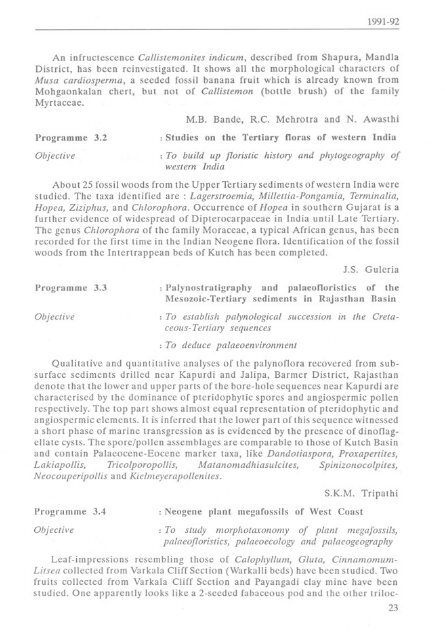1991-92 - Birbal Sahni Institute of Palaeobotany
1991-92 - Birbal Sahni Institute of Palaeobotany
1991-92 - Birbal Sahni Institute of Palaeobotany
- No tags were found...
You also want an ePaper? Increase the reach of your titles
YUMPU automatically turns print PDFs into web optimized ePapers that Google loves.
<strong>1991</strong>-<strong>92</strong>An infructcscence Callisremonites indicum, described from Shapura, MandlaDistrict, has been reinvestigated. It shows all the morphological characters <strong>of</strong>Musa cardiosperma, a seeded fossil banana fruit which is already known fromMohgaonkalan chert, but not <strong>of</strong> Callistemon (bOll Ie brush) <strong>of</strong> the familyMyrtaceae.M.B. Bande, R.C. Mehrotra and N. AwasthiProgramme 3.2Objective,Studies on the Tertiary noras <strong>of</strong> western India,To build up f/oristic history and phytogeography <strong>of</strong>western IndiaAbout25 fossil woods from the Upper Tertiary sediments <strong>of</strong> western India werestudied. The taxa identified are: Lagerstroemia, Millettia-Pongamia, Terminalia,Hopea, ZiziphllS, and Chlorophora. Occurrence <strong>of</strong> Hopea in southern Gujarat is afurther evidence <strong>of</strong> widespread <strong>of</strong> Dipterocarpaceae in India until Late Tertiary.The genus Chlorophora <strong>of</strong> the family Moraceae, a typical African genus, has beenrecorded for the first time in the Indian Neogene flora. Identification <strong>of</strong> the fossilwoods from the Intertrappean beds <strong>of</strong> Kutch has been completed.J.S.GuleriaI'rogramme 3.3 : Palynostratigraphy and palaeonoristics <strong>of</strong> thel\fesozoic~Tertiary sediments in Rajasthan RasinObjective,To establish palynological succession in the Cretaceous-Tertiary sequences: To deduce palaeoenvironmentQualitative and quantitative analyses <strong>of</strong> the palyn<strong>of</strong>lora recovered from subsurfacesedimcnts drillcd near Kapurdi and Jalipa, Barmer District, Rajasthandenote that the lowcr and upper parts <strong>of</strong> the bore-hole sequences near Kapurdi arecharacterised by the dominance <strong>of</strong> pteridophylic spores and angiospermic pollenrespectively. The 101' part shows almost equal representation <strong>of</strong> pteridophylie andangiospermic elements. It is inferred Ihatthe lower part <strong>of</strong> this sequence witnesseda short phase <strong>of</strong> marine transgression as is evidenced by the presence <strong>of</strong> din<strong>of</strong>lagellatecysts. The spore/pollen assemblages are comparable 10 those <strong>of</strong> Kutch Basinand conlain Palaeocene-Eocene marker taxa. like Dandotiaspora, Proxapertites,Lakiapollis, Tricolporopollis, Matanomadh iasillcites, Spinizonocolpites,Neocouperipollis and Kielmeyerapollenites.Programme 3.4ObjectiveS.K.M.,Neogene plant megafossils <strong>of</strong> West CoastTripathi: To study morphotaxonomy <strong>of</strong> plant megafossils,palae<strong>of</strong>/oristics, palaeoecology and palaeogeographyLeaf-impressions resembling those <strong>of</strong> Calophyllum, Gluta, CinnamomllmLilsea collected from Yarkala CliffSeclion (Warkalli beds) have been studied. Th<strong>of</strong>ruits collectcd from Yarkala Cliff Section and Payangadi clay mine have beenstudied. One apparently looks like a 2-seeded fabaceous pod and the other triloc-23
















